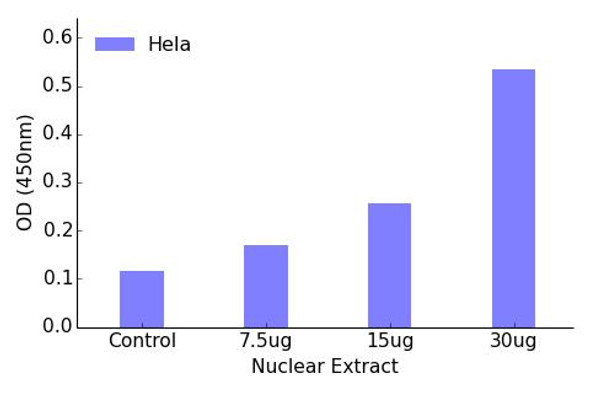CREB Transcription Factor Activity Assay
- SKU:
- TFAB00087
- Product Type:
- ELISA Kit
- ELISA Type:
- Transcription Factor Assay
- Analytes:
- CREB
- Reactivity:
- Human
- Mouse
- Rat
Description
CREB Transcription Factor Activity Assay
The CREB Transcription Factor Activity Assay Kit is specifically designed for the quantitative measurement of CREB (cAMP response element-binding protein) activity in cell lysates or tissue samples. This kit offers high sensitivity and specificity, allowing for accurate and reliable results in various research applications.CREB is a key transcription factor that regulates gene expression in response to various stimuli, including growth factors, stress, and neurotransmitters. Its activity plays a critical role in processes such as cell proliferation, differentiation, and survival.
Dysregulation of CREB activity has been implicated in numerous diseases, including cancer, neurological disorders, and metabolic disorders.By accurately measuring CREB activity, researchers can gain valuable insights into the molecular mechanisms underlying these diseases and potentially identify new therapeutic targets. The CREB Transcription Factor Activity Assay Kit provides a powerful tool for studying CREB signaling pathways and developing novel treatment strategies.
| Product Name: | CREB Transcription Factor Activity Assay |
| Product Code: | TFAB00087 |
| Target: | CREB |
| Reactivity: | Human, Mouse, Rat |
| Sample Types: | Nuclear or cell lysates |
The Assay Genie CREB transcription factor activity assay allows for the detection and qualitative analysis of endogenous levels of activated transcription factors in a variety of nuclear and cell lysates
Assay Genie ELISA kits are designed to significantly reduce experiment time and ensure sensitivity and flexibility for high-throughput screening.
| Assay Time: | 4.5 hours |
| Detection Method: | Colorimetric 450 nm |
| Size: | 12 x 8-Well Microstrips |
| Storage: | 4°C for 6 months |
| UniProt Protein Function: | Function: This protein binds the cAMP response element (CRE), a sequence present in many viral and cellular promoters. CREB stimulates transcription on binding to the CRE. Transcription activation is enhanced by the TORC coactivators which act independently of Ser-133 phosphorylation. Implicated in synchronization of circadian rhythmicity. |
| UniProt Protein Details: | Subunit structure: Interacts with PPRC1. Binds DNA as a dimer. This dimer is stabilized by magnesium ions. Interacts, through the bZIP domain, with the coactivators TORC1/CRTC1, TORC2/CRTC2 and TORC3/CRTC3. When phosphorylated on Ser-133, binds CREBBP By similarity. Interacts (phosporylated form) with TOX3. Interacts with ARRB1. Ref.8 Ref.9 Ref.11 Ref.13 Ref.14 Ref.15 Ref.16 Ref.20 Subcellular location: Nucleus Ref.12. Post-translational modification: Stimulated by phosphorylation. Phosphorylation of both Ser-133 and Ser-142 in the SCN regulates the activity of CREB and participates in circadian rhythm generation. Phosphorylation of Ser-133 allows CREBBP binding By similarity. Phosphorylated upon DNA damage, probably by ATM or ATR. Ref.10 Ref.17 Ref.19Sumoylated by SUMO1. Sumoylation on Lys-304, but not on Lys-285, is required for nuclear localization of this protein. Sumoylation is enhanced under hypoxia, promoting nuclear localization and stabilization. Ref.12 Involvement in Disease: Defects in CREB1 may be a cause of angiomatoid fibrous histiocytoma (AFH) [ MIM:612160]. A distinct variant of malignant fibrous histiocytoma that typically occurs in children and adolescents and is manifest by nodular subcutaneous growth. Characteristic microscopic features include lobulated sheets of histiocyte-like cells intimately associated with areas of hemorrhage and cystic pseudovascular spaces, as well as a striking cuffing of inflammatory cells, mimicking a lymph node metastasis. Note=A chromosomal aberration involving CREB1 is found in a patient with angiomatoid fibrous histiocytoma. Translocation t(2;22)(q33;q12) with CREB1 generates a EWSR1/CREB1 fusion gene that is most common genetic abnormality in this tumor type. Sequence similarities: Belongs to the bZIP family.Contains 1 bZIP domain.Contains 1 KID (kinase-inducible) domain. |
| NCBI Summary: | This gene encodes a transcription factor that is a member of the leucine zipper family of DNA binding proteins. This protein binds as a homodimer to the cAMP-responsive element, an octameric palindrome. The protein is phosphorylated by several protein kinases, and induces transcription of genes in response to hormonal stimulation of the cAMP pathway. Alternate splicing of this gene results in two transcript variants encoding different isoforms. [provided by RefSeq] |
| UniProt Code: | P16220 |
| NCBI GenInfo Identifier: | 117434 |
| NCBI Gene ID: | 1385 |
| NCBI Accession: | P16220.2 |
| UniProt Secondary Accession: | P16220,P21934, Q9UMA7, |
| UniProt Related Accession: | P16220,Q16366,Q16367,Q4ZG78,Q53RU9,Q53X93,Q5U0J5,Q6V963 |
| Molecular Weight: | 40 kDa |
| NCBI Full Name: | Cyclic AMP-responsive element-binding protein 1 |
| NCBI Synonym Full Names: | cAMP responsive element binding protein 1 |
| NCBI Official Symbol: | CREB1 |
| NCBI Official Synonym Symbols: | CREB; MGC9284 |
| NCBI Protein Information: | cyclic AMP-responsive element-binding protein 1; CREB-1; OTTHUMP00000163864; OTTHUMP00000163865; OTTHUMP00000206660; OTTHUMP00000206662; OTTHUMP00000206667; transactivator protein; active transcription factor CREB; cAMP-response element-binding protein-1; cAMP-responsive element-binding protein 1 |
| UniProt Protein Name: | Cyclic AMP-responsive element-binding protein 1 |
| Protein Family: | CREB-binding protein |
| UniProt Gene Name: | CREB1 |
| UniProt Entry Name: | CREB1_HUMAN |









